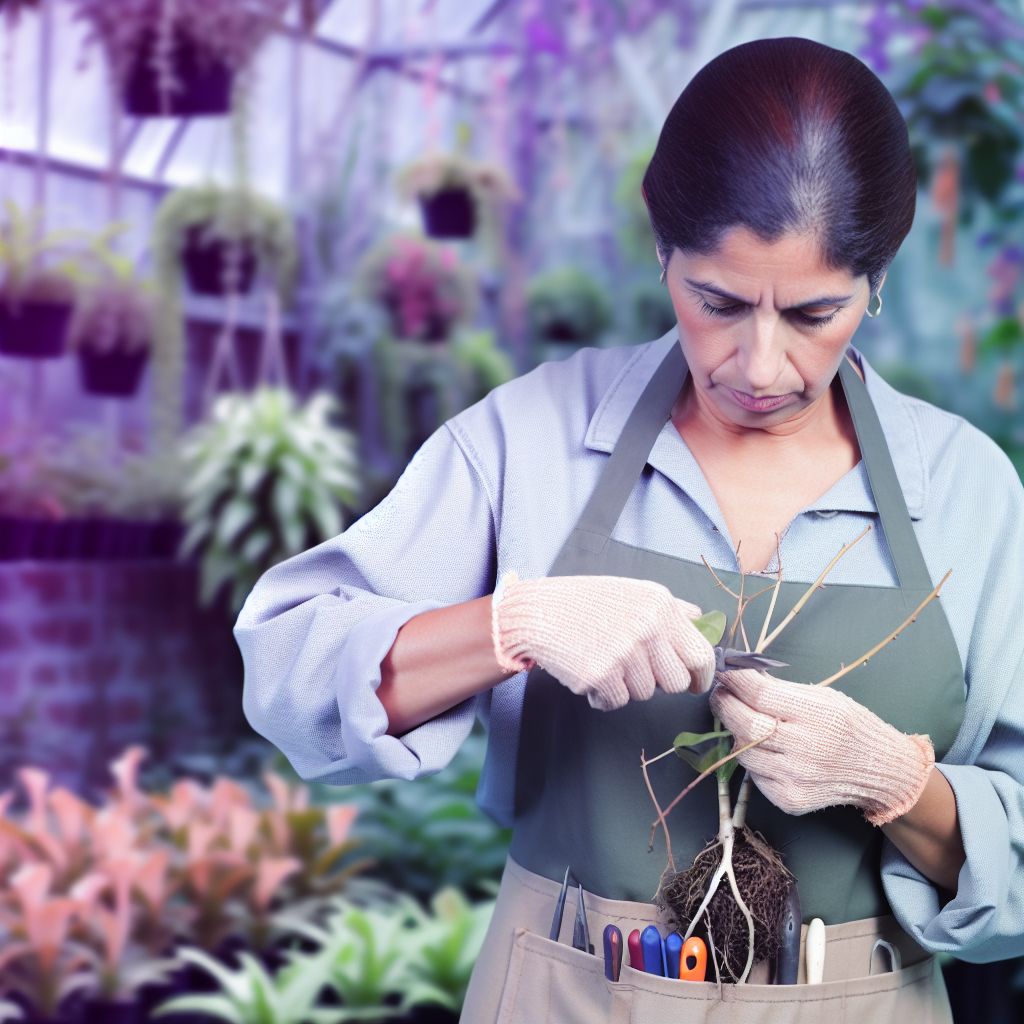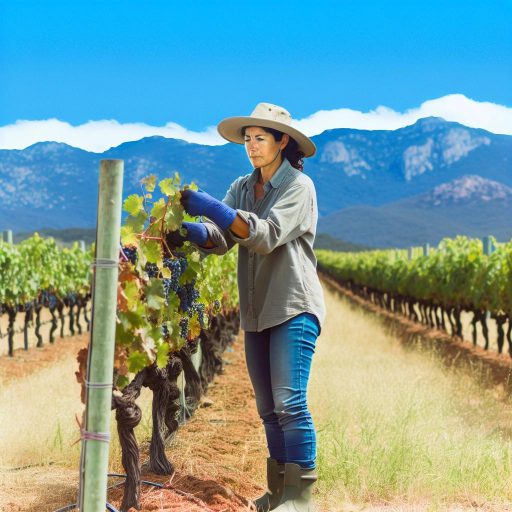Introduction:
Plant propagation is the process of reproducing plants through various methods such as seeds, cuttings, grafting, and tissue culture.
It plays a crucial role in agriculture, horticulture, and forestry industries.
Brief overview of plant propagation techniques:
Traditional plant propagation techniques include seed sowing, division, and cutting.
These methods have been used for centuries to grow new plants from existing ones.
Importance of advanced techniques in plant propagation:
Advanced techniques in plant propagation offer several advantages over traditional methods.
They allow for the rapid multiplication of plants, enhanced disease resistance, and the production of genetically identical clones.
Furthermore, advanced techniques such as tissue culture provide a controlled environment for plant growth.
This controlled environment results in higher success rates and faster growth compared to traditional methods.
These advanced techniques also enable the propagation of rare and endangered plant species that are otherwise challenging to grow using conventional methods.
Overall, incorporating advanced techniques in plant propagation helps meet the increasing demand for plants in various industries.
It ensures genetic purity and contributes to conservation efforts by preserving rare and valuable plant species.
Advanced Techniques in Plant Propagation
Grafting and budding are common methods used in advanced plant propagation techniques.
These methods involve joining parts of different plants to create a new plant with desired characteristics.
Grafting is the process of joining the stem of one plant (the scion) onto the rootstock of another plant.
This technique is often used to combine the desirable traits of two different plants.
Budding is a type of grafting where a single bud from one plant is inserted into the rootstock of another plant.
This method is commonly used in fruit tree propagation.
Air layering is another advanced technique used to propagate plants with woody stems.
This method involves creating a wound on a branch, applying rooting hormone, and wrapping the area with moist materials to encourage root formation.
Tissue culture, also known as micropropagation, is a cutting-edge technique used to propagate plants from small pieces of plant tissue.
Transform Your Career Today
Unlock a personalized career strategy that drives real results. Get tailored advice and a roadmap designed just for you.
Start NowThis method allows for the rapid production of a large number of plants with identical genetic makeup.
In tissue culture, plant cells are grown in a sterile, nutrient-rich environment to promote growth and development.
This technique is commonly used to produce disease-free plants, rare species, and plants with specific traits.
Advanced plant propagation techniques like grafting, budding, air layering, and tissue culture require careful planning, skill, and knowledge of plant biology.
These methods can be used to produce new plant varieties, preserve endangered species, and improve crop productivity.
Mastering advanced plant propagation techniques opens up new possibilities for plant breeders, horticulturists, and conservationists.
By incorporating these methods into their practice, plant enthusiasts can broaden their skills and contribute to the diversity and sustainability of plant populations.
Benefits of Advanced Techniques
When it comes to plant propagation, utilizing advanced techniques can offer a wide range of benefits.
One of the key advantages of using advanced propagation techniques is the significantly higher success rate that can be achieved.
Traditional methods of propagation such as seed sowing or cutting can sometimes result in failures due to environmental factors or improper handling.
By utilizing advanced techniques such as tissue culture or micropropagation, the success rate can be increased due to the controlled environment and precise conditions provided.
Another significant benefit of advanced techniques in plant propagation is the ability to propagate rare or unique plant varieties.
Some plant species are challenging to propagate through traditional methods, especially those that are endangered or have specific requirements.
Advanced techniques allow for the propagation of these plants by providing the necessary conditions for their growth and development, ensuring the preservation of these rare species.
Furthermore, advanced techniques offer a faster propagation process compared to traditional methods.
With techniques such as air-layering, grafting, or micropropagation, plants can be propagated at a much quicker pace.
This allows for a higher volume of plants to be produced in a shorter amount of time.
This is especially useful for commercial growers looking to increase their plant stock or introduce new varieties to the market.
The benefits of utilizing advanced techniques in plant propagation are extensive.
Showcase Your Business Today
Reach thousands of readers actively exploring professional services. Publish your business profile and grow your audience now.
Publish NowFrom increased success rates to the ability to propagate rare species and quicker propagation processes, advanced techniques offer a range of advantages for growers and plant enthusiasts alike.
- Increased success rate
- Ability to propagate rare or unique plant varieties
- Faster propagation process
You Might Also Like: Using Satellite Imagery in Precision Agriculture
Tools and Materials:
When it comes to advanced techniques in plant propagation, having the right tools and high-quality materials is essential for success.
Here is an overview of tools needed for advanced techniques, the importance of using high-quality materials, and where to purchase these tools and materials:
Tools Needed for Advanced Techniques:
- Sharp, clean pruning shears for cutting stems and leaves
- Rooting hormone to promote root development
- Heat mats or propagators to maintain ideal temperature for propagation
- Misting system or spray bottle for watering
- Propagation trays or pots to hold the cuttings
These tools are crucial for successful propagation and ensuring that your plants grow healthy and strong.
Importance of Using High-Quality Materials:
Using high-quality tools and materials is important for several reasons:
- Quality tools are more durable and long-lasting, saving you money in the long run
- High-quality materials promote better growth and reduce the risk of disease or pests
- Sharp tools make cleaner cuts, promoting faster root development in cuttings
- Well-made equipment ensures more accurate and consistent results in plant propagation
Investing in good tools and materials will enhance your success in plant propagation and lead to healthier, more robust plants.
Where to Purchase Tools and Materials:
There are many places where you can purchase tools and materials for advanced plant propagation:
- Garden centers and nurseries often carry a wide variety of propagation supplies
- Online retailers offer a convenient way to browse and purchase tools and materials
- Specialty stores that focus on gardening or horticulture may have unique or hard-to-find items
- Local hardware stores can also be a good source for basic tools like pruning shears and spray bottles
Whether you prefer to shop in person or online, there are plenty of options for sourcing the tools and materials you need for advanced plant propagation.
Discover More: Forest Management Techniques for Conservationists
Step-by-Step Instructions:
Choose a healthy plant for propagation.
Prepare your tools and equipment.
Make a clean, diagonal cut on the plant stem.
Align the cut sections of the scion and rootstock.
Secure them by wrapping with grafting tape.
Allow time for the graft to heal and grow.
Monitor the progress of the graft regularly.
Keep the newly grafted plant in a stable environment.
Detailed instructions for grafting and budding:
Identify the best time for grafting based on plant type.
Ensure tools are sterilized to prevent infections.
Cut a bud or stem from the donor plant.
Prepare the receptor plant by making a T-shaped incision.
Insert the bud or stem into the incision.
Secure with grafting tape or rubber band.
Water the plant properly after grafting.
Monitor the graft for signs of success.
Step-by-step guide for air layering:
Select a lateral branch for air layering.
Make a circular cut through the bark and cambium layer.
Apply rooting hormone to the exposed area.
Wrap the cut with moisture-retaining material.
Wait for roots to form at the air layer site.
Carefully remove the air layer once roots are established.
Plant the new rooted cutting in a separate pot.
Keep the newly rooted plant well-watered and monitored.
Overview of the tissue culture process:
Select a healthy plant with desirable traits.
Collect a small tissue sample from the plant.
Disinfect the tissue using sterilization techniques.
Place the tissue in a nutrient-rich culture medium.
Allow the tissue to grow into plantlets in a controlled environment.
Transplant the plantlets into soil once they are established.
Showcase Your Business Today
Reach thousands of readers actively exploring professional services. Publish your business profile and grow your audience now.
Publish NowMonitor and care for the tissue-cultured plants as they grow.
Repeat the process to propagate more plants through tissue culture.
Uncover the Details: Exploring Job Opportunities in Horticulture

Tips and Tricks:
Advanced plant propagation techniques require careful attention to detail.
With the right tips and tricks, you can increase your success rate significantly.
Use of Growth Regulators:
One advanced technique is the use of growth regulators to stimulate root growth in cuttings.
This promotes faster and healthier propagation.
Bottom Heating:
Another tip is to provide bottom heating for your propagation trays.
This can speed up the rooting process and improve overall success rates.
Mist Propagation:
Consider mist propagation systems to maintain humidity levels.
This keeps your cuttings moist without oversaturating them.
It promotes healthy root development.
Common mistakes to avoid in advanced plant propagation:
While advanced propagation techniques can be highly effective, there are common mistakes.
These can hinder your success if not addressed properly.
Overcrowding:
A common mistake is overcrowding your propagation trays.
This can lead to increased competition for resources.
It may result in poor root development.
Insufficient Light:
Avoid placing your propagation trays in areas with insufficient light.
Insufficient light can slow down the rooting process.
It can also weaken your cuttings.
Improper Watering:
Be careful not to overwater or underwater your cuttings.
Both can lead to issues such as root rot or dehydration.
This impacts overall success rates.
How to troubleshoot common issues:
Even with advanced techniques, you may encounter issues during the propagation process.
Here are some tips for troubleshooting common problems.
Yellowing Leaves:
If you notice yellowing leaves on your cuttings, it could be a sign of nutrient deficiency.
Consider adjusting your fertilization regimen accordingly.
Mold or Fungus:
To combat mold or fungus growth, improve air circulation around your cuttings.
Avoid using excessive moisture in your propagation trays.
Stunted Growth:
If your cuttings are showing signs of stunted growth, check your temperature and humidity levels.
Extremes in either can hinder root development.
Tips for successful propagation using advanced techniques:
To increase your chances of successful propagation using advanced techniques, follow these tips.
Monitor Environment:
Regularly monitor temperature, humidity, and light levels in your propagation area.
This ensures optimal conditions for root development.
Keep Records:
Keep detailed records of your propagation experiments.
This includes variables such as growth regulators used, propagation medium, and success rates.
Experiment and Learn:
Don’t be afraid to experiment with different techniques.
Learn from your failures.
Each propagation attempt is an opportunity to refine your skills.
See Related Content: Extension Agents and Environmental Stewardship
Showcase Your Business Today
Reach thousands of readers actively exploring professional services. Publish your business profile and grow your audience now.
Publish NowCase Studies:
Let’s delve into real-life examples of successful plant propagation using advanced techniques.
Case Study 1: Air Layering of Fruit Trees
A seasoned gardener, John, propagated his apple tree using air layering.
He wrapped a branch with soil and saw new roots develop.
Case Study 2: Stem Cutting of Succulents
Mary, an experienced botanist, successfully propagated her collection of succulents through stem cuttings.
She ensured the cuttings had at least two nodes.
Testimonials:
Here are testimonials from gardeners and botanists who have mastered advanced plant propagation techniques.
Testimonial 1 – Anna, Gardener for 10 Years
“Using advanced techniques like grafting has transformed my garden.
The plants thrive, and I’ve even created my hybrids!”
Testimonial 2 – Dr. Smith, Botanist
“I’ve experimented with tissue culture propagation and achieved fantastic results.
It’s a game-changer in conservation efforts for rare species.”
Photos and Videos:
Visuals speak volumes. Here are photos and videos showcasing advanced plant propagation techniques in action.
Video 1: Grafting a Citrus Tree
Watch as a gardener demonstrates the meticulous process of grafting a lemon branch onto a lime tree.
Photo 1: Tissue Culture in a Lab
Behold the sterile environment where tissue culture propagation takes place, ensuring rapid multiplication of plant cells.
By learning from these case studies, testimonials, and visual aids, you can elevate your plant propagation skills to new heights.
Importance of Advanced Techniques in Plant Propagation
Using advanced techniques in plant propagation can significantly enhance the efficiency of growing plants.
These techniques help improve the success rate of propagation, increase yield, and allow for the preservation of rare and endangered plant species.
Encouragement to Explore Propagation Methods
By incorporating advanced propagation techniques, gardeners can expand their knowledge and skills.
This leads to a more fulfilling gardening experience.
Share Your Experiences with the Gardening Community
We encourage readers to experiment with these methods.
Share your successes and challenges with the gardening community to foster learning and growth.
Additional Resources
Starting a Flower Farm on a Budget: Affordable Tips and Smart …
Details – Assistant Plant Breeder (Blueberry … – University of Florida
[E-Books for Sale]
The Big Book of 500 High-Paying Jobs in America: Unlock Your Earning Potential
$19.99 • 500 High-Paying Jobs • 330 pages
Explore 500 high-paying jobs in America and learn how to boost your career, earn more, and achieve success!
See All 500 High-Paying Jobs of this E-Book
1001 Professions Without a Degree: High-Paying American Jobs You Can Start Now
$19.99 • 1001 Professions Without a Degree • 174 pages
Discover 1001 high-paying jobs without a degree! Unlock career tips, skills, and success strategies for just $19.99!




